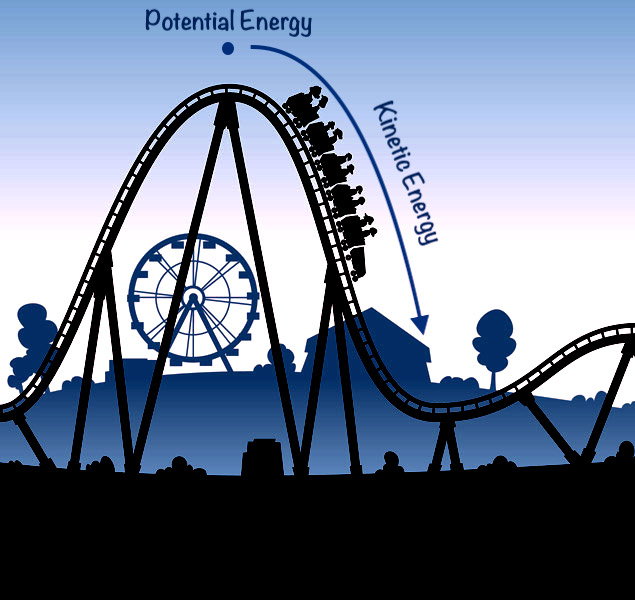Potential Energy and Kinetic Energy
Who doesn’t love a thrilling ride on a roller coaster? The excitement when the cart slowly goes up, the suspense when the cart stops at the peak, and of course, the feeling of exhilaration when the cart swoops down at full speed!
Have you ever wondered how a roller coaster works?
The motor pulls the cart to the top and are stopped with brakes. This builds a lot of potential energy at the peak due to Gravity. When the brakes are pulled off, with the help of gravity, the potential energy is converted to kinetic energy and the cart swoops down. Due to the speed and mass of the cart, there is enough kinetic energy generated for the cart to move upward. The kinetic energy is maximum at the bottom of the free-fall. When the cart goes back upwards from the bottom point, the kinetic energy gets converted to potential energy. This potential energy is again converted to kinetic energy when the cart starts moving downward. This goes on in a loop until the cart reaches the end point of the track, where brakes are applied to bring it to a halt!


Let us go a little deeper into these phenomena!
Potential Energy:
How is Potential Energy
defined?
Potential energy is the energy possessed by an object by virtue of
its position or configuration.
What does this mean?
The energy that is stored or conserved in an object or
particle, based on the position, arrangement or state of the object or
substance. It is the energy that has the ‘potential’ to do
work.
In the above example, when the cart is at the peak of the roller coaster track, the cart has maximum potential energy built up. It is this potential energy that gets converted to kinetic energy when the cart starts moving.
Let us learn how to calculate potential energy:
If an object of mass ‘m’ is at a height of ‘h’, then its potential energy is,
PE = mgh
where, g is the gravitational constant, i.e. 9.8 m/s2.
Potential energy is measured in units of ‘joules’, which is equal to kg x m2/s2
For example, let us assume the roller coaster cart weighs 1000 kgs, and the peak is at a height of 100 m, then the potential energy of the cart at the peak will be:
PE = mgh
PE = 1000 x 9.8 x 100
PE = 9,80,000 J
Let us see a few more real-life examples of potential energy:
- Water behind a dam
- A pulled rubber band
- A blown balloon before it is pierced
- A bicycle at the top of a hill
Kinetic Energy:
How is kinetic energy defined?
Kinetic energy is the energy that an object or a particle possesses due to its
motion.
What does this mean?
The energy that an object or particle gets when it starts to move from a point
of
rest is called kinetic energy.
In the above example, from a point of rest at the peak of the roller coaster track, the cart starts swooping down. The energy created when its moving downward is Kinetic Energy.
Let us learn how to calculate kinetic energy:
If an object of mass m has velocity v, then its kinetic energy KE is,
KE = 1/2 mv2
Kinetic energy is measured in units of ‘joules’, which is equal to kg x m2/s2
For example, let us assume the roller coaster cart weighs 1000 kgs and is moving at a speed of 25 m/s, then the kinetic energy of the cart will be:
KE = 1/2 mv2
KE = 1/2 x 1000 x 252
KE = 1/2 x 1000 x 625
KE = 625000/2
KE = 312500 J
Let us see a few more real-life examples of Kinetic Energy:
- A bicycle in motion
- A baseball when the hitter strikes
- A flying airplane
- A moving car
Now let us see how to calculate the velocity of an object when the mass and
kinetic energy values are given.
Going back to the roller coaster example,
let us assume the mass of the cart is 700kgs and the KE is 140000 J, then the
velocity v is,
KE = 1/2 mv2
v2 = 2KE / m
v = √2KE / √m
v = √2(140000) / √700
v = √280000 / √700
v = √400
v = 20 m/s
∴ The roller coaster is moving at a velocity of 20 m/s.
– Dhanyajeeth K
